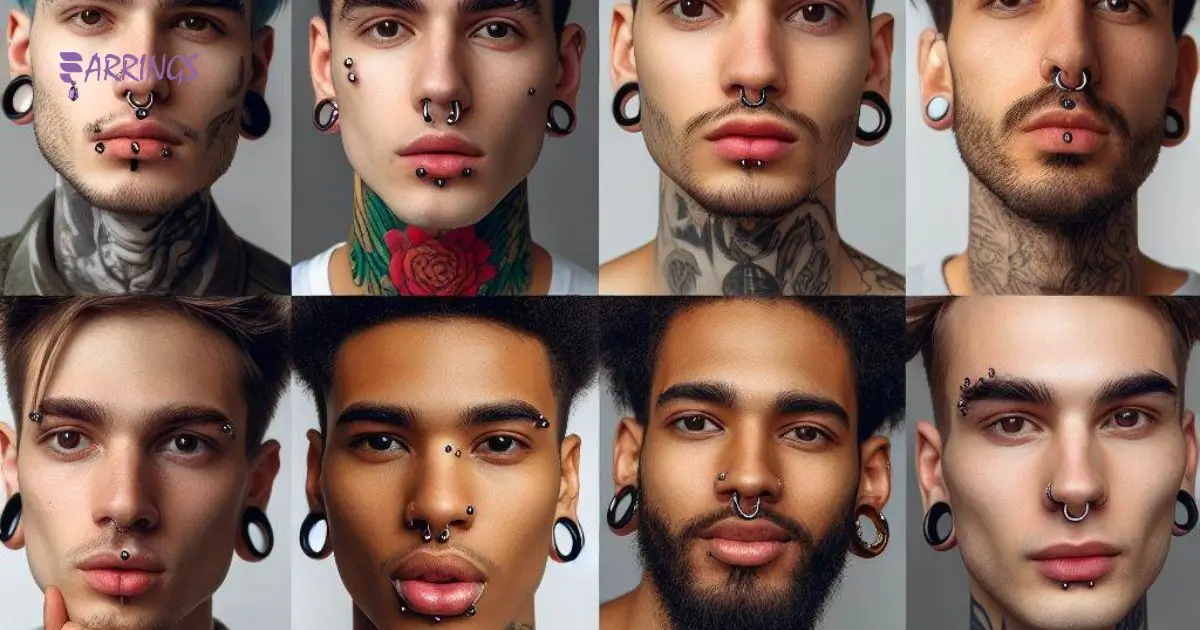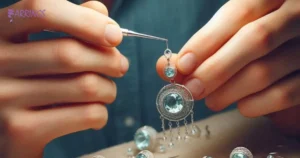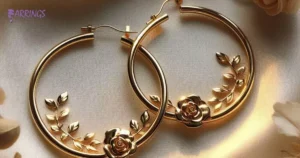Cartilage piercing is body piercing through the firm connective tissue of the ears or nose. It is popular with men who seek unique or edgy body art. The healing process takes longer than earlobe piercings. Proper jewelry must be worn to prevent rejection or infection.
Cartilage piercing men make a bold style choice with edgy body art. Piercing through the firm ear or nose cartilage allows for unique looks. The process can be painful with risks of bleeding and infection. Proper jewelry and diligent aftercare are critical for healing.
These piercings are not for the faint of heart. The process begins by piercing through the firm cartilage of the ear or nose. Tolerating significant pain and proper jewelry choices are essential. Guys wear earrings in both ears. Intensive aftercare routines like sea salt soaks must be followed diligently.
Key Takeaways
- Cartilage piercings for men offer a stylish form of self-expression.
- Various placement options include helix, tragus, conch, and rook.
- Jewelry options range from subtle studs to bold hoops and barbells.
- Healing time is longer than earlobe piercings, typically several months to a year.
- Professional piercing ensures hygiene, safety, and precision.
- Choose a piercing that reflects personal style and boosts confidence.
Definition Of Cartilage Piercing
A cartilage piercing is a type of body modification where the cartilage of the ear is pierced to insert jewelry. This piercing can be done in various locations on the ear, offering different aesthetic options. Men often choose cartilage piercings as a way to express their personal style and individuality.
The healing process for piercings cartilage typically takes longer compared to earlobe piercings, requiring proper aftercare to minimize the risk of infection. It’s essential to have cartilage piercings done by a professional piercer to ensure cleanliness and precision. Ultimately, the choice of jewelry and placement reflects the wearer’s unique taste and preference, adding a stylish accent to their look.
The Helix Piercing?
| Aspect | Description |
| Placement | Outer rim of the upper ear cartilage |
| Healing Time | Typically 3 to 9 months, varies based on aftercare |
The helix piercing is a popular choice for men seeking a stylish addition to their look. It’s placed on the outer rim of the ear, offering a subtle yet striking aesthetic. With a wide range of jewelry options available, from simple studs to intricate hoops, men can personalize their helix piercing to match their style.
Healing time for a helix piercing is typically longer than earlobe piercings, often taking several months to fully heal. It’s crucial to have the piercing done by a professional to ensure precision and minimize the risk of complications. Overall, the helix piercing is a versatile option for men looking to express their individuality with a trendy and fashionable accessory.
Industrial Piercing Men
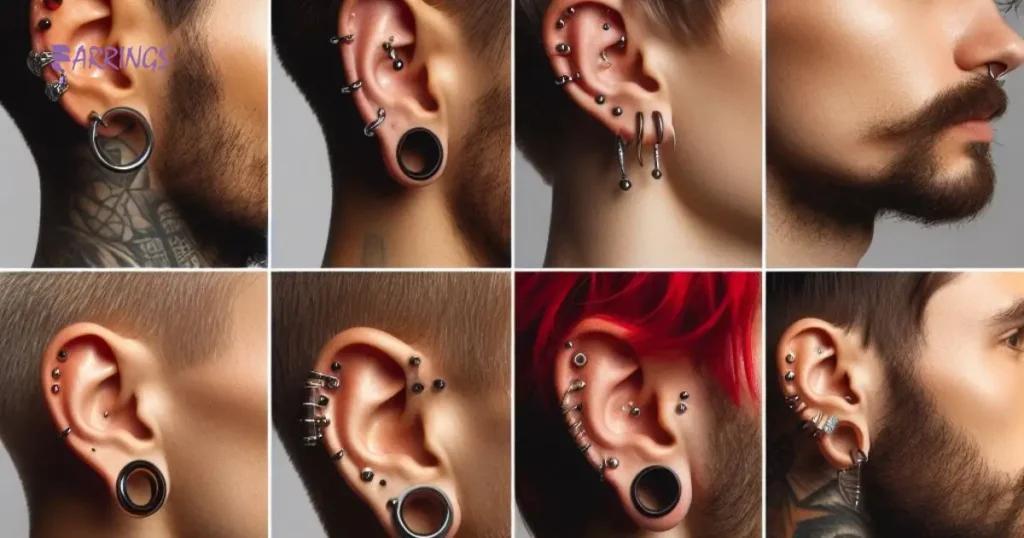
Industrial piercings for men are a bold choice for self-expression. They consist of a barbell that traverses the upper ear cartilage, creating an edgy look. Placement options typically involve two piercings connected by a single bar.
When considering an industrial piercing, men should prioritize professional piercing services. This ensures proper hygiene and reduces the risk of complications. With proper aftercare, industrial piercings can be a stylish addition to a man’s look, reflecting his personal style with confidence.
Mens Cartilage Piercing Hoop
Men’s cartilage piercing with hoops is a trendy choice. You can get the hoop in various sizes and styles, from small and subtle to larger and more eye-catching. Placement options include the helix, tragus, or even the conch for a unique look.
Hoops offer a versatile option for expressing your personal style, you prefer a minimalist aesthetic or a bolder statement. Professional piercing is essential to ensure a clean and precise placement, reducing the risk of complications. To follow proper aftercare to promote healing and keep your piercing looking its best.
Double Helix Piercing Men
Double helix piercings for men offer a stylish way to adorn the ear. They involve two piercings along the helix, adding symmetry and depth to the look. Men can choose from a variety of jewelry options, such as studs, hoops, or rings, to suit their personal style.
Healing time for double helix piercings is similar to other cartilage piercings, often taking several months. It’s crucial to have them done by a professional piercer to ensure precision and reduce the risk of complications. With proper aftercare, double helix piercings can be a bold and confident statement for men seeking to express their individuality through body modification.
Helix Ear Piercing
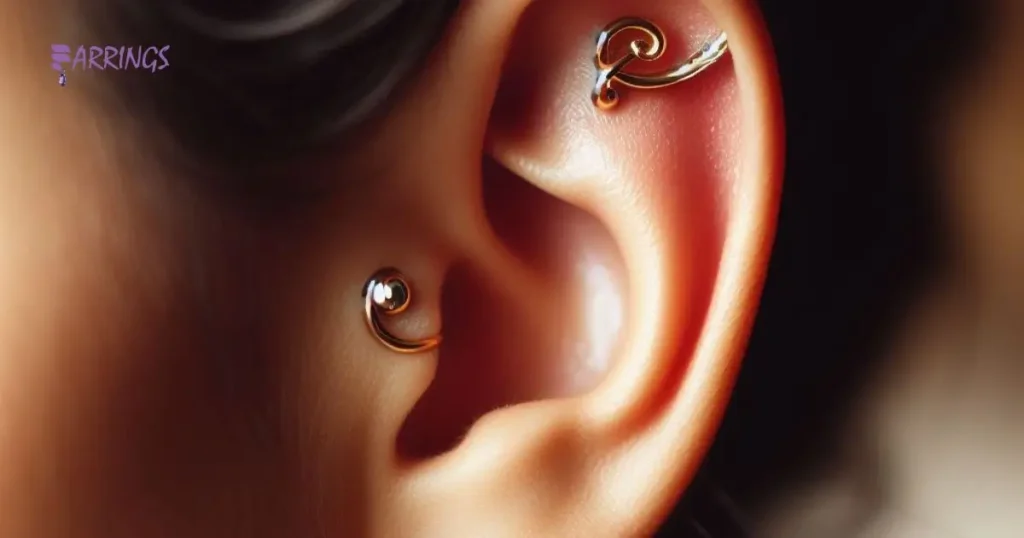
Helix ear piercing is a trendy choice for men, offering a stylish way to accessorize. It involves piercing the upper cartilage of the ear, creating a distinctive look. This placement allows for various jewelry options, from studs to hoops, catering to different styles.
Healing time for helix piercings can range from a few months to a year, requiring proper aftercare to prevent infection. It’s essential to have the piercing done by a professional to ensure precision and minimize risks. Ultimately, helix ear piercings enable men to express their personal style with confidence, adding a subtle or bold statement to their appearance.
Types Of Cartilage Piercings
Sure, there are several types of cartilage piercings that people commonly get. Here are some of the most popular ones:
Helix Piercing: This is a piercing done through the upper cartilage of the ear, typically on the outer rim.
Forward Helix Piercing: Similar to the helix piercing, but done closer to the front of the ear.
Conch Piercing: This piercing is done in the center of the ear cartilage, usually in the concave shell-shaped area.
Rook Piercing: Located on the antihelix of the ear, between the inner and outer ridges.
Tragus Piercing: This piercing goes through the small flap of cartilage that partially covers the ear canal.
Anti-Tragus Piercing: Opposite to the tragus, this piercing goes through the small nub of cartilage on the outer side of the ear, just above the earlobe.
Snug Piercing: Placed through the inner cartilage ridge, parallel to the outer rim of the ear.
Daith Piercing: Located in the innermost fold of the cartilage above the ear canal.
Industrial Piercing: Also known as a scaffold piercing, this involves two piercings connected by a single barbell, usually across the upper ear cartilage.
These are just some of the most common cartilage piercings, but there are many variations and creative placements people explore within the cartilage of the ear.
How To Get Cartilage Pierced?
To get a cartilage piercing, start by researching reputable piercing studios in your area. Look for places with experienced piercers who prioritize hygiene. Once you’ve found a studio, schedule an appointment. Before your appointment, eat a good meal and avoid alcohol to reduce the risk of fainting.
When you arrive, your piercer will discuss placement and jewelry options with you. They’ll clean the area and mark the spot for piercing. The piercing itself is quick but may be uncomfortable. Afterward, follow your piercer’s aftercare instructions closely to promote healing and minimize the risk of infection.
Preparing For Cartilage Piercing

When preparing for a cartilage piercing, start by researching the different placement options available for men. Decide where on the ear you want the piercing to be. Then, look into the various styles and types of jewelry, from simple studs to more elaborate hoops or rings. Next, find a professional piercer with a good reputation and make an appointment.
Make sure to ask about their hygiene practices and how they ensure a safe and clean procedure. Finally, mentally prepare for the healing process, knowing that cartilage piercings often take longer to heal than earlobe piercings. Follow the aftercare instructions provided by your piercer closely to minimize the risk of infection and promote proper healing.
Choosing A Piercing Studio
When choosing a piercing studio, prioritize hygiene and safety. Look for clean, well-maintained facilities with trained professionals. Make sure the studio follows strict sterilization procedures to prevent infections.
Ask about the piercers’ experience and certifications. Experienced piercers are more likely to provide precise, comfortable piercings. Don’t hesitate to ask questions about the piercing process and aftercare instructions. A reputable studio will be happy to provide information and address any concerns you may have.
Cartilage Piercing Healing Time
Cartilage piercing healing time varies but often takes several months to a year. Proper care is crucial to prevent infection and promote healing. Follow the aftercare instructions provided by your piercer diligently. Avoid touching or twisting the piercing to prevent irritation. Patience is key; give your piercing the time it needs to heal fully.
Average Healing Time
Cartilage piercing healing time varies greatly, often ranging from several months to a year. Patience and proper aftercare are essential for a successful healing process. Follow your piercer’s instructions closely to minimize the risk of complications.
Factors Affecting Healing
Several factors can influence cartilage piercing healing time. Proper aftercare, including cleaning and avoiding irritation, is essential. Individual differences in healing rates and the location of the piercing can impact how long it takes to heal fully.
Cartilage Piercing Aftercare
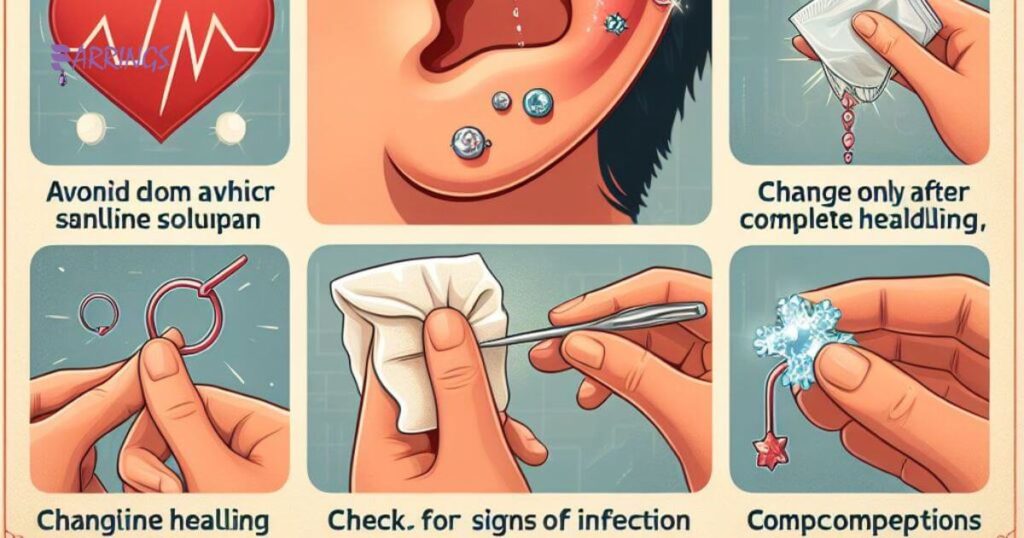
After getting a cartilage piercing, it’s crucial to follow proper aftercare to ensure healing goes smoothly. Clean the piercing twice a day using a saline solution or mild soap and water. Avoid touching the piercing with dirty hands to prevent infection. Use a clean towel to gently pat the area dry after cleaning.
Avoid sleeping on the pierced ear to prevent irritation and promote healing. During the healing process, it’s essential to avoid swimming pools, hot tubs, and bodies of water to prevent bacteria exposure. Be mindful of clothing and accessories that may snag on the piercing and cause discomfort.
Cartilage Piercing Jewelry
Cartilage piercing jewelry adds flair to men’s style. It comes in various designs: studs, hoops, rings, and barbells. Choose what suits your look and personality best. You prefer subtle elegance or bold statements, there’s an option for you.
These piercings take time to heal. Expect several months to a year for full recovery. Ensure proper aftercare to prevent infections. Professional piercers guarantee precision and safety. Make a confident choice that reflects your unique style.
Choosing The Right Jewelry
When it comes to choosing the right jewelry for cartilage piercings, men have a variety of options. From simple studs to bold hoops, the choice depends on personal style and preference. It’s important to consider the placement of the piercing and how the jewelry will complement it.
Opting for professional piercing ensures precision and reduces the risk of complications. Aftercare plays a crucial role in healing, so selecting jewelry that is comfortable and easy to clean is essential. By keeping these factors in mind, men can find the perfect jewelry to accentuate their cartilage piercings and express their individuality confidently.
Cartilage Piercing Infections
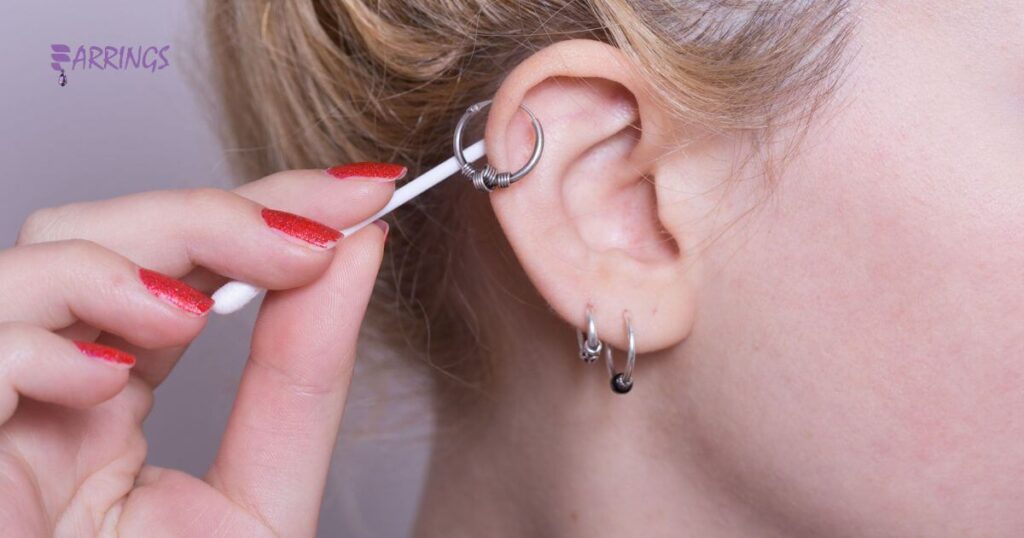
Cartilage piercings can sometimes get infected. It’s crucial to keep them clean to prevent this. Wash your hands before touching your piercing and clean it daily with saline solution. If you notice any signs of infection, such as redness, swelling, or discharge, see a doctor promptly.
Infections can prolong healing time and lead to complications. Avoid swimming in pools or bodies of water until your piercing is fully healed. Follow the aftercare instructions provided by your piercer carefully. With proper care, most cartilage piercings heal without any issues.
Cartilage Piercing Swelling
Cartilage piercing swelling is common after getting pierced. It’s your body’s natural response to the trauma of piercing. Swelling usually peaks within 48 hours but can last up to a week or more. Applying a cold compress can help reduce swelling and alleviate discomfort.
To manage swelling effectively, avoid touching or moving the piercing excessively. Keep the area clean and dry, following the aftercare instructions provided by your piercer. If swelling persists or worsens, consult a healthcare professional for further guidance. Patience and proper care are key to a successful healing process.
Frequently Asked Questions
What Piercing Looks Best On A Guy?
The best piercing for a guy depends on personal style and can range from subtle cartilage piercings to bold studs or hoops.
Is Cartilage Piercing Painful?
Cartilage piercing pain is usually a quick pinch or pressure, varying based on individual tolerance and location, with soreness afterward that typically subsides within a week.
Which Side Male Ear Piercing?
The side of a male ear piercing is often a personal choice, but traditionally, left ear piercings may be associated with masculinity.
Conclusion
Cartilage piercings offer men a versatile form of self-expression. With various placement and jewelry options available, individuals can find a style that suits them. It’s crucial to remember that healing time can vary, influenced by factors like aftercare and individual differences.
By prioritizing proper care and patience, men can enjoy their cartilage piercings fully. Consulting with a professional piercer and following their advice ensures a safe and stylish experience. Ultimately, cartilage piercings can be a meaningful addition to one’s look, reflecting personal style and individuality.
